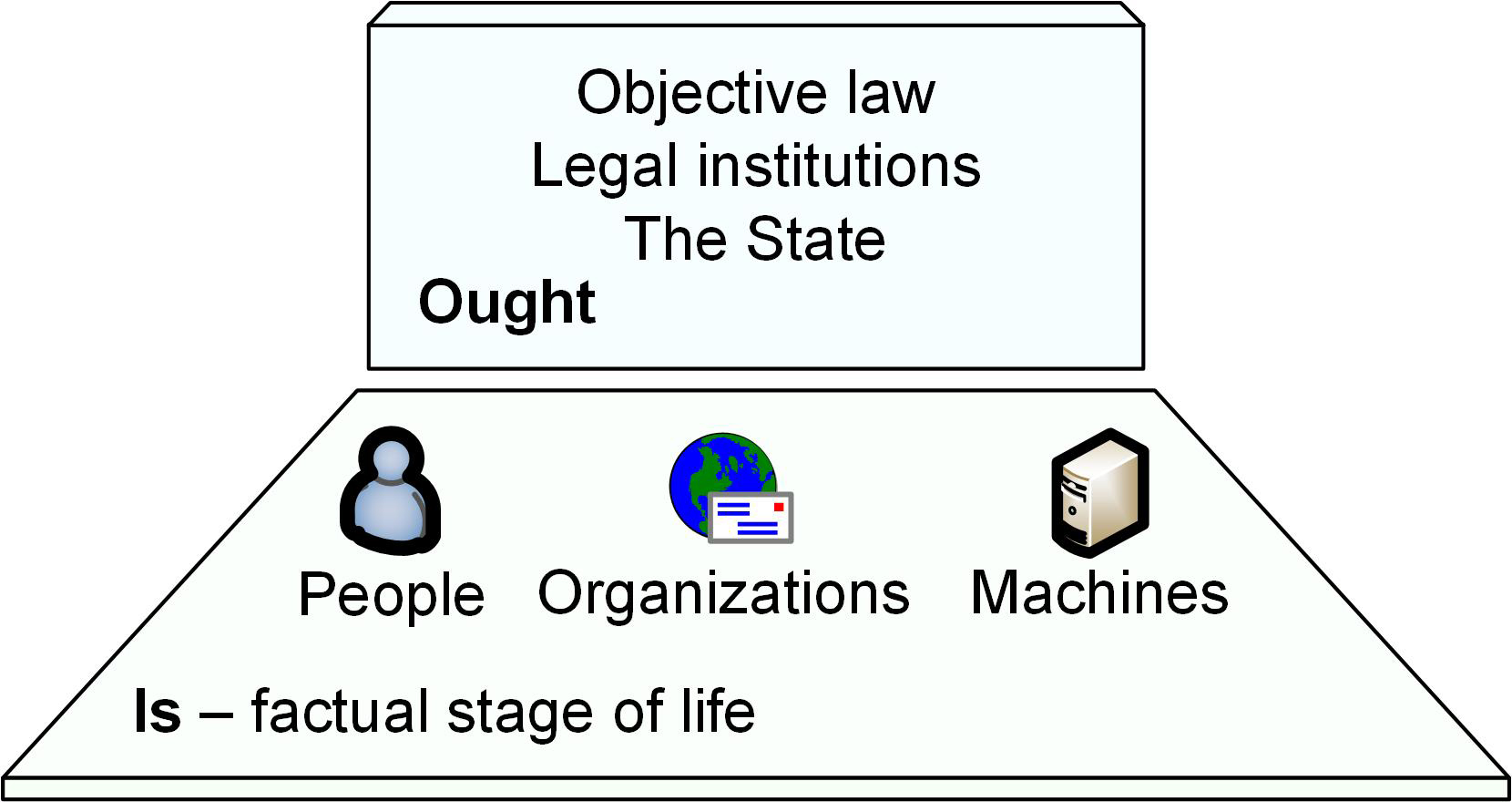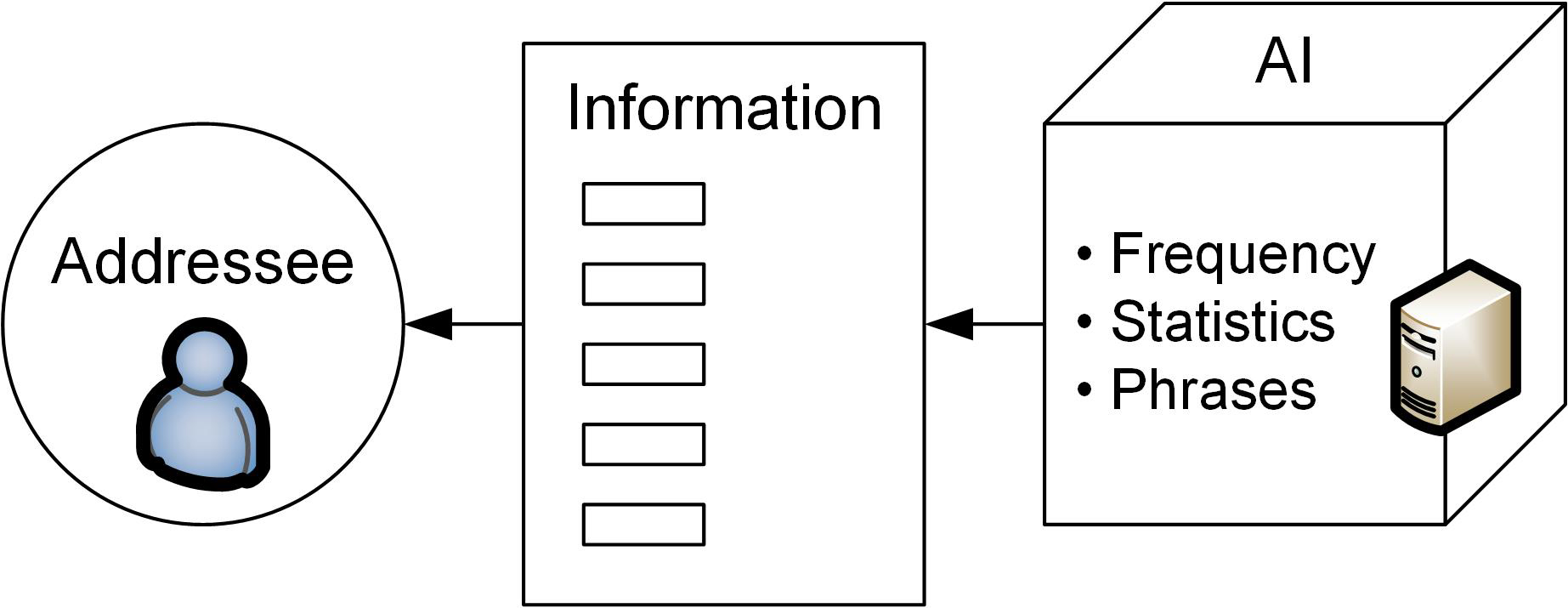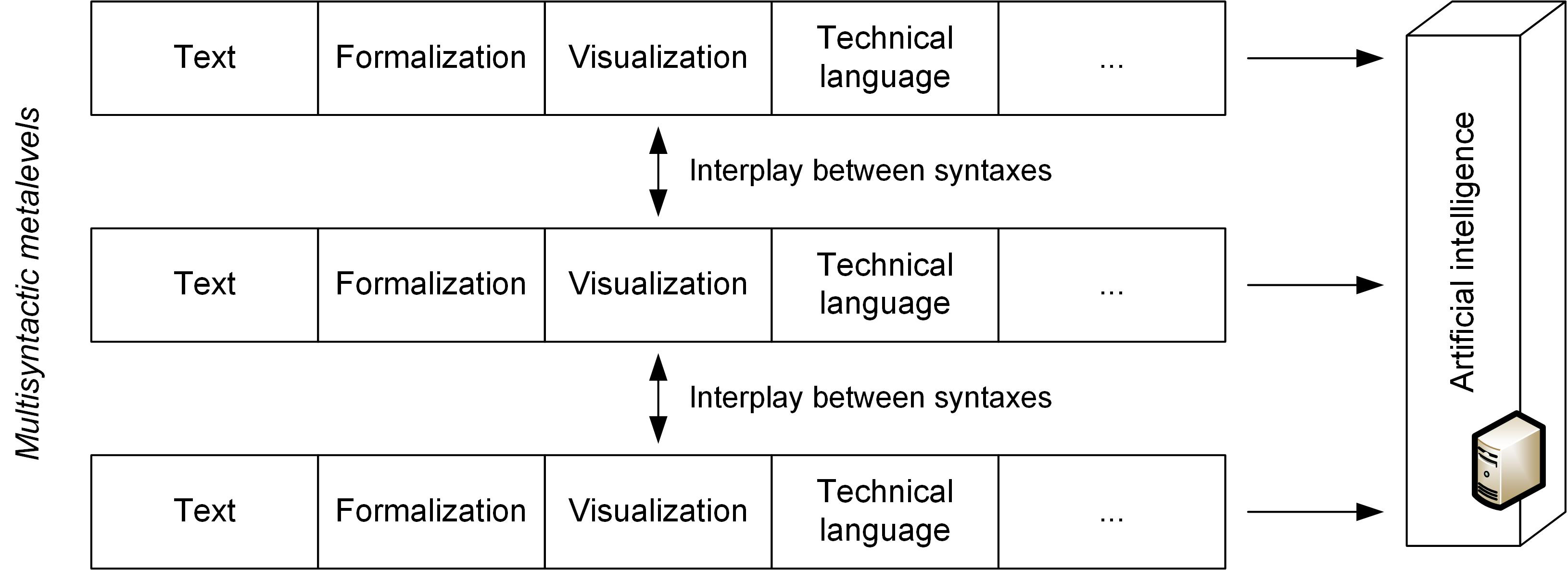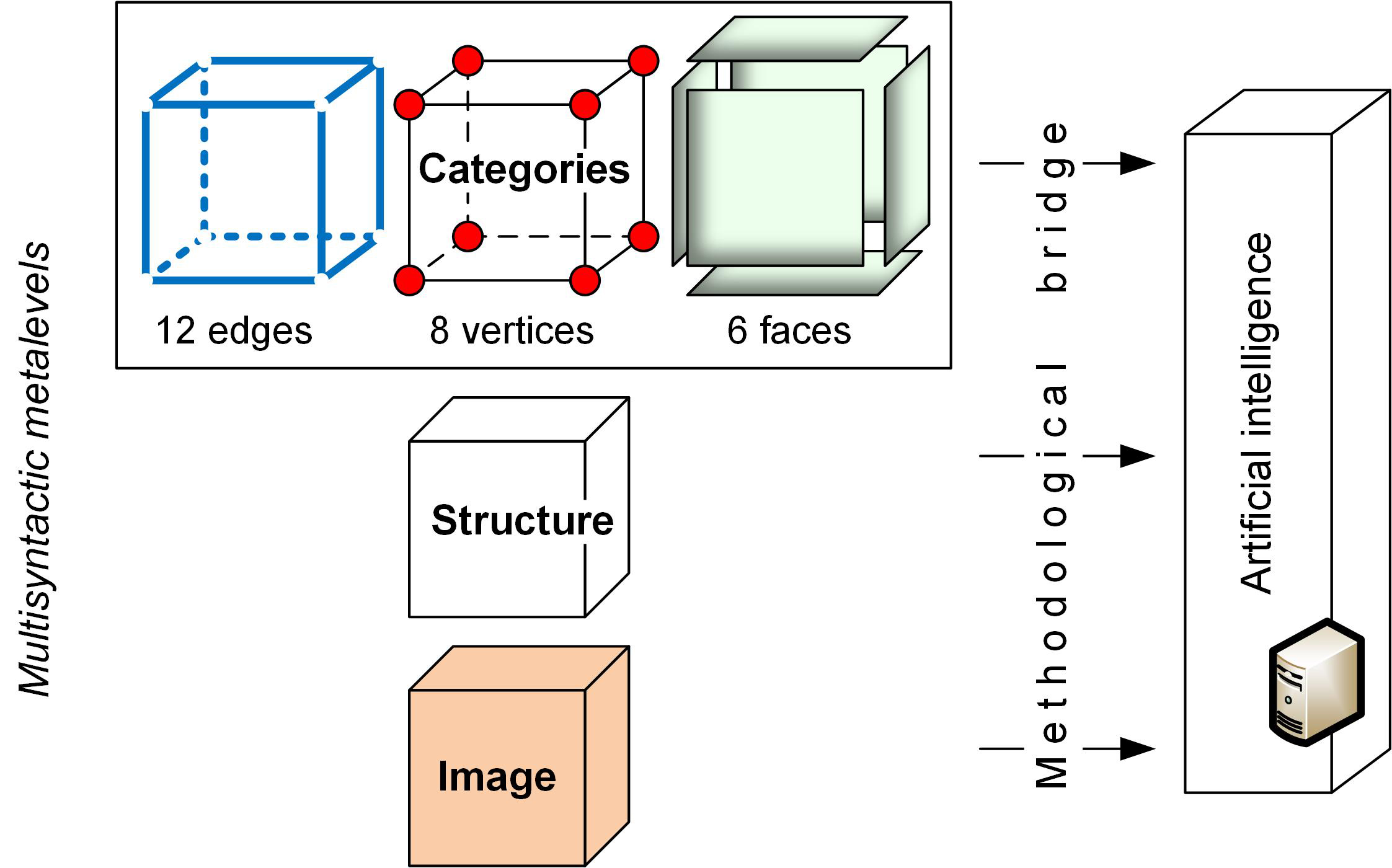1.
Introduction ^
The law was initially developed on the everyday stage of life, for example in regard to road traffic, which is comparable to customary law situations (see Figure 1).

Figure 1: The Is stage of everyday life, where legal situations take place
Everyday life is governed by legal institutions, which, in the event of a conflict interpret the situation professionally and prescribe sanctions. Legal institutions rest on legal texts. In the context of everyday life, however, the law appears in various forms, which are not necessarily highly institutionalized legal norms. The methodological approach of Multisensory Law, developed by Colette Brunschwig, offers analytical instruments for this [Brunschwig 2018]. Machine-based standard settings, such as traffic lights for road traffic, have already been designed; however, these ‘legal machines’, which operate as actors in the legal sense, are undergoing qualitative upgrade through artificial intelligence (AI).
The professional metalevels of law are structured in layers; one example is the step-by-step model of the legal system. The interplay between jurisprudence, legal dogmatic and legislation rests on vertical and horizontal layers, and their syntax has traditionally been textual.
We use the term ‘nontextual notations’ primarily to mean the legal visuals and formalizations that contribute to the representation of law using computers. The key concepts and metalevels of interest in this paper are depicted in Figure 2, which has two columns: the first column is devoted to law, while the second is devoted to technology [Čyras/Lachmayer 2023 a, 278].

Figure 2: Legal metalevels in the transition of legal content from law to machines; adapted from [Čyras/Lachmayer 2023 a, 278]
There have been various attempts to move away from the dominance of textual syntax in law, with one such attempt known as ‘legal logic’: in Austria, Ota Weinberger and especially Ilmar Tammelo [Tammelo 1978] undertook to create a logical form of textually written standards through logical notation. Various visualizations are also worth mentioning here.
The design principles of AI also affect human mentality, as human thinking will adapt to AI in the same way as human thought partially acts as a model for AI. Thus, machines can be added to the evolutionary process, as plants–animals–people–machines.
2.
Legal Machines in the Context of Biological Evolution ^
Legal machines can be viewed from the perspective of evolution, the process of change that affects all forms of life. Consider the line of evolution from plants to animals to human beings to machines shown in Figure 3 [Cyras/Lachmayer 2023 b, 251–252].

Figure 3: The evolutionary process is supplemented with machines [Cyras/Lachmayer 2023 b, 252]
In the proposed model, biological evolution leads to the development of human beings. The last step, however, which involves the evolution from humans to machines, is a process of technological evolution in which humans produce machines. Moreover, humans strive to give human capabilities to their creations, thus making machines artificially intelligent, a situation that is reminiscent of the ancient myth of Pygmalion and its modern variations.
One question associated with the evolutionary step from humans to machines is whether machines reside in status civilis or status naturalis. A relapse to status naturalis is a permanent temptation of modern culture, although re-barbarization is a kind of political atavism. Weapons are substitutes for the former raptors [Cyras/Lachmayer 2023 b, 252 ff].
Various criteria are used to compare living organisms and machines; for example, rockets fly faster than birds, ships are larger than dinosaurs, and the capability of computers to process data exceeds the mental abilities of humans. Thus, machines have a distinct quality. We see three alternative approaches to considering the development of machines that are equipped with AI, and more specifically, legal machines. Firstly, machines serve human interests and conform to the law, and such machines fall within the scope of legal informatics, where the judge makes the final decision. Secondly, machines can act independently of humans and can serve higher interests. Thirdly, machines are compliant actors on the legal stage. In summary, machines have emerged at a qualitatively new level of evolution.
3.
Multisensority of Legal Machines ^
As AI-controlled actors in everyday life, the external components of legal machines must be adapted to take into account human competencies; for example, speech synthesized by a machine needs to be adapted to the speed of human language. Acoustic driving instructions from the GPS are therefore needed to ensure that the speed of speech is appropriate for understanding by humans.
An agent (human or machine) may perceive the legal aspects of a situation via multiple senses (sight, hearing, smell, taste and touch). Thus, a kind of multi-sensory legal communication is observed [Cyras/Lachmayer 2023 b, 206], as shown in Figure 4.

Figure 4: Different input-output formats for perceiving a situation and multisensory communication
A situation can be understood and interpreted differently via different senses. In a situation, traditional customary law and machine law are in the foreground. For example, consider a pedestrian crosswalk: pedestrians use it to cross a road, and statutory law (road rules) regulates this situation. However, ordinary people are governed primarily by customary law, which is superimposed on this context. Finally, the situation is governed by traffic lights, meaning that machine law enters the frame [Cyras/Lachmayer 2023 b, 12].
4.
Structural Competence of AI for Legal Machines ^
Legal machines need to be given competence in terms of legal subsumption. Legal subsumption concerns the relation between a fact and a normative condition (Lebenssachverhalt und gesetzlicher Tatbestand; Sachverhalt und Tatbestand der Norm) [Larenz and Canaris 1995, 91 ff.], and can be divided into three steps: (i) fact-finding, (ii) cognitive subsumption (also known as factual or terminological subsumption), and (iii) normative subsumption (see Figure 5).

Figure 5: The subsumption of a fact under a norm [Cyras/Lachmayer 2023 b, 188]
In the first step, fact-finding, raw facts are given the qualification of legally important facts, i.e., legal facts. In the second step, cognitive subsumption, the facts of a case are transformed into legal terms. Suppose that an action, a, is treated as a theft, A, rather than a burglary; in this case, we can write a ~ A. A pool of legal terms is used for cognitive subsumption.
In the third step, normative subsumption, a general norm N(A→B) is applied and a legal consequence arises in the form of a decision. We can write Norm("x A(x) → B(x) ) is applied to conclude B. A key question is that of who interprets the facts in subsumption: a human or a machine.
To sum up, a legal machine must accomplish all three steps, thus producing (i) findings of a fact, (ii) the legal meaning of the fact in legal terms, and (iii) a legal decision.
5.
Rhetoric for Argumentation in the Legal Expert Report ^
Around 1985, the second author dealt with the rhetoric of legal argumentation, as his professional practice involved the examination of draft laws (bills) with regard to legislative standards. The result of such an examination is an expert opinion in the form of a legislative report. A large number of bills and reports were analyzed, firstly in terms of the usage of the words and phrases in the professional juridical language, and secondly to clarify the deep structures containing contradictions [Lachmayer 1989]. This analysis focused on the structure and shades of legislative technology, and aimed to develop a communication-friendly legal jargon. The analysis also illustrated the depth of juridical problems.
Expert opinions form a part of rational discourse in the sense of a juridical dialogue, and consist primarily of arguments that are structured in a certain way. The structure of an argument is not only a logical problem, but primarily one of the traditional rhetoric in the field. It is surprising that the types of arguments used alter only slightly over time; traditional types of argument have remained essentially unchanged over a period of four decades.
As part of the legislative process, there are various procedural contexts in which a passage in a text is selected. Initially, the bill is created with accompanying documents containing explanations and dispatch notes. The passage is transformed through the different stages of the legislative process, and the draft bill ultimately becomes law. Along this path to becoming the law, there are numerous checks in which the identifying features of the draft are checked and created anew. The function of language is not only to convey a message, but also to add significance in the sense of legitimacy. Empirical studies allow for reconstruction of this language to a certain extent.
There are five main parts (see Figure 6) that are empirically established in the argumentation process for writing a legal expert’s report on a legislative draft: (1) quoting the text, (2) paraphrasing the text, (3) structural meaning, (4) assessment, and (5) opinions/suggestions (revision).

Figure 6: The five phases of the writing process for an expert’s opinion on a legislative text
- Quoting the text. A legal text, usually a bill, is quoted verbatim.
- Paraphrasing the text. The text is repeated with an interpretation in alternative words, which are used in practice to emphasize the relevant passages of the text. However, paraphrasing is carried out in the legal frame.
- Structural meaning. The aim of structural interpretation is to identify problematic passages. Technical legal terms are used to formalize legal meaning; for example, a “prohibition” or “sub-delegation” may be concerned. Mistakes, shortcomings and defects are diagnosed. The person conducting the assessment applies her professional competence. The legal meaning of the text is most important in this phase, and leads to a metalevel at which the problem is formulated. At this metalevel, a separate argument may be involved. The facts of a case gain structural importance.
- Assessment. When the meaning of the case is clear, the legal text is assessed, for example as “problematic”, “inadmissible”, etc. This assessment can be flexible and may range from “unconstitutional” to “it does not seem completely impossible that this formulation is constitutionally problematic”. Politeness in evaluation is not crucial, as it shows the direction of the evaluation.
- Opinions/suggestions concerns improving the legislative draft. There are different improvements, such as deleting certain wordings, suggesting improved formulations and new wordings.
In the suggestions, the legist focuses on the final legal meaning. The words are important as the suggestions require minimum critique and acceptance by other experts. The individual practice of a legist rests on several factors, such as rhetoric, a corpus of legal phrases and synonyms, and the statistics of phrases. A corpus of hundred pages of phrases can be used manually. As a result, the synthetic language of legists becomes immune for critique.

Figure 7: Communication between machine and human
Dealing with meaning poses a challenge to AI, and the automatic synthesis of an expert opinion and the suggestions by a computer is not a trivial task. However, the achievement of certain partial tasks associated with automatic synthesis seems to be realistic. A legist writes suggestions in a semi-synthetic language; hence, one task for legal machine developers would be to design a similar synthetic language (see Figure 7). There are two requirements for a synthetic language and the structure of argumentation: the first is that the machine’s synthetic language is immune for linguistic critique, while the second is that the machine’s argumentation must be structurally similar to the legist’s argumentation.
6.
Middle-level Abstraction ^
We introduce three layers of abstraction in the legislative domain, as shown in Figure 8 [Cyras/Lachmayer 2023 b, 178–180]:
- Formal abstraction (in other words, high-level abstraction);
- Middle-level abstraction (interpretative abstraction);
- Substantive abstraction (low-level abstraction).

Figure 8: Three levels of abstraction [Cyras/Lachmayer 2023 b, 178]
We focus here on middle-level abstraction, as we hold that it offers more potential for legal informatics, AI and legal machines.
Formal abstraction. This is not as dynamic as middle-level and substantive abstraction. Once found, it stays that way. The following works can be mentioned as examples: Tammelo’s notation for the legal domain (1978); Jerzy Wróblewski’s analytical theory of law (1992); Ota Weinberger’s legal logic (1989); Ernst Mally’s formalization of moral will (1926); and Kazimierz Opałek’s logic of wishes (utinam) (1986). Various sorts of formal logic are used here.
Middle-level abstraction. At this layer, Kelsen’s Pure Theory of Law is a relevant example. We find a mixture of formal structuring and material closeness at this level, which is more flexible than the other two. This is the area of scientific progress. On the one hand, there is potential for abstraction in this layer; on the other, substantive matters are not forgotten. It should be noted that the content of concrete norms is not examined in this layer.
An example of formalization at this level of abstraction, drawn from the field of chemistry, is a chemical formula notation such as H2O. Experience shows that reasoning with such formulas and their graphical models is very effective. Examples of structural notation include relationships such as causation A →causal B and teleology A →telos B, and a model of legal norms such as Norm(A→B). Creativity with ontologies in the legal domain can also be assigned to this layer.
Substantive abstraction. In substantive disciplines such as legal theory and legal dogmatics, an object is described with words. However, these disciplines are of less interest here, since abstraction is too concrete and it is difficult to raise it to an upper layer. The content of concrete norms is examined in this layer, in contrast to the two upper layers.
It is difficult to invent at the top layer, that is, at the formal abstraction layer. For the same reason, we also do not focus on substantive abstraction. For instance, once an article in a law consists of a complete list of variations, it is hard to add more. However, we hold that creativity can be demonstrated at the middle abstraction layer. Formalization of the interpretations of facts can be assigned to the middle level of abstraction. One example would be ontologies. We aim at structuring the legal domain, namely, the big picture of the structure. In this layer, new formal notations could still be introduced that are not too far from the substantive content. This stands in contrast to certain people who work at a low level and can interpret legal texts, but find it difficult to grasp the whole structure correctly.
7.
Multisyntactic Metalevels of Law ^
Each multisyntactic metalevel of law consists of one or more descriptions: textual, formalized, visual, technical language, etc. (see Figure 9). Each description is expressed in a different syntax; a textual description, for example, is formed from words. A formalized description is written in a certain formalism, such as mathematical logic, whereas a visual description consists of diagrams, images or pictures.

Figure 9: The interplay between multisyntactic metalevels and the richness of informational inputs to AI systems
In the case of the overlay of several metalevels, different syntaxes can be linked, and a complex interplay between syntaxes can take place, which may provide an opportunity for creativity. Thus, the input to AI may be rich in different representations. A flat, linear input consisting of words does not represent a challenge for AI; however, creativity and a variety of syntaxes do pose a challenge. As a result, AI may gain flexibility through varying inputs. Thus, AI benefits from multisyntactic metalevels, especially when making a decision in a certain situation (see Figure 10). Hence, situational intervariation (i.e, variation between multiple inputs in different syntaxes) becomes an object of research.
The idea of multisyntactic metalevels can be linked with the notion of view (perspective) in software engineering [Sowa/Sachmann 1992]. We think about the multisyntactic metalevels in light of views in Schweighofer’s 8 views / 4 methods / 4 syntheses model1 and project the core and peripheral areas around the legal system onto his model [Schweighofer 2015].

Figure 10: Legal machines with AI benefit from multisyntactic metalevels
8.
Conclusion ^
The paper is about the landscape in which the new developments are taking place and is less about pointing out individual aspects. Multisyntactic metalevels for AI are important in order to expand the information base for AI, and are not solely dependent on text. AI applications are also being developed for everyday situations. Hence, situational components, such as spatial structures or temporal flow charts, need to be made explicit in a non-textual way.
The goal of this research is to develop a methodological bridge (see Figure 10) from multisyntactic levels to AI. This bridge consists of multiple arches, one of which is legal visualization. The methodological bridge from multisyntactic metalevels to AI needs to take into account AI architectures and distinct notions of view in legal analysis and software engineering.
9.
References ^
Brunschwig, Colette, Perspektiven einer digitalen Rechtswissenschaft: Visualisierung, Audiovisualisierung und Multisensorisierung. Perspectives of Digital Law: Visualization, Audiovisualization, and Multi-Sensorization, Max Planck Institute for European legal history research paper series no. 2018-03, Frankfurt am Main 2018. Available at https://ssrn.com/abstract=3126043.
Čyras, Vytautas/Lachmayer, Friedrich (a), Nontextual Notations as Syntactic Supplements. In: Schweighofer, Erich/Zanol, Jakob/Eder, Stefan (Eds.), Legal Informatics as Science of Legal Methods, Proceedings of the 26th International Legal Informatics Symposium IRIS 2023, Editions Weblaw, Bern 2023, pp. 277–282. Also, online in Jusletter IT, 27 April 2023. https://doi.org/10.38023/f7cd2a25-6803-4658-96fb-8040bf78aa83.
Cyras, Vytautas/Lachmayer, Friedrich (b), Essays on the Visualisation of Legal Informatics. Law, Governance and Technology Series, vol 54. Springer, Cham, 2023. https://doi.org/10.1007/978-3-031-27957-7
Lachmayer, Friedrich, Die Fachsprache legislative Gutachten. Zeitschrift für Gesetzgebung, Verlag C. H. Beck, 4. Jahrgang, Heft 1, 1989, pp. 81–87.
Larenz, Karl/Canaris, Claus-Wilhelm, Methodenlehre der Rechtswissenschaft, 3. Auflage. Springer, Heidelberg 1995.
Schweighofer, Erich, From Information Retrieval and Artificial Intelligence to Legal Data Science. In: Schweighofer Erich/ Galindo, Fernando/ Cerbena, Cesar (Eds), Proceedings MWAIL2015, ICAIL Multilingual Workshop on AI & Law Research, 15th International Conference on Artificial Intelligence and Law (ICAIL 2015), books@ocg.at, vol 313. OCG, Vienna 2015 pp. 13–23. http://fedora.phaidra.univie.ac.at/fedora/get/o:399570/bdef:Content/get.
Sowa, John F./Zachman, John A., Extending and Formalizing the Framework for Information Systems Architecture. IBM Systems Journal 1992, 31(3):590–616.
Tammelo, Ilmar, Modern Logic in the Service of Law. Springer, Vienna, 1978.
- 1 The eight views (or representations of law) are: (1) the text corpus view; (2) the metadata view; (3) the citation network view; (4) the user view; (5) the logical view; (6) the ontological view; (7) the visualization view; and (8) the argumentation view. The four computer-supported methods of analysis are: (1) interpretation (searching, reading, and understanding); (2) documentation (searching and processing); (3) structural analysis (both conceptual and logical); and (4) facts analysis. The four syntheses are: (1) a commentary or electronic legal handbook; (2) a dynamic electronic legal commentary (DynELC); (3) a representation for citizens; or (4) a case-based synthesis.





